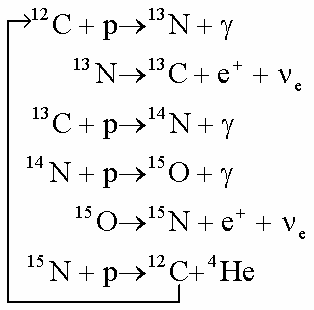
CNO Cycle

Last but not least, the CNO cycle, or the Carbon - Nitrogen - Oxygen cycle. Yes it's a mouthful!
The CNO cycle is used as a power source by giants as they furiously attempt to keep going and maintain their luminosity, despite their dwindling fuel.
As seen with the PP chain, and the triple alpha process, the CNO cycle is simple and elegant. It is also perhaps the most interesting as the overall net result is simply a loss of 4 protons, and a gain of 1 Helium nuclei, just like the PP chain, however much more energy is released.
The CNO cycle begins by fusing a carbon nuclei with a proton to make Nitrogen-13. The Nitrogen-13 isotope then decays releasing a positron and a neutrino, leaving behind Carbon-13.
Carbon-13 fuses with a proton to make a stable Nitrogen nuclei.
The Nitrogen then fuses with yet another proton to form the isotope Oxygen-15.

Just as with the Nitrogen-13 isotope, the Oxygen-15 decays, releasing a positron and a neutrino, and Nitrogen-15.
Finally the Nitrogen-15 isotope fuses with one last proton to form a stable Carbon nuclei and a Helium nuclei.
At each fusion stage energy is released as gamma radiation; and at each decay phase a positron and neutrino is released. This type of decay is known as beta positive decay.
To the left is the CNO cylce simplified into equation format.
